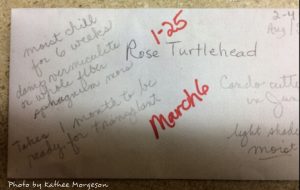By Kathee Morgeson
Wild Ones – St. Louis Chapter Member
If you are a novice like me, seeking information to expand your adventures into native plants, the answer seems to be available. Network with people who have the knowledge stored away. I find “plant people” always want to share their experiences. Let’s start simply.
Once you have labeled and stored your seed in a cool, dry place, you can start planning your timetable for planting. You have two basic choices to make. You can use Kathy Bildner posted information about what to do in fall to plant. Or you can plant seeds indoors which includes learning about cold stratification, scarification, and other seed treatments. There are links below to help guide you through the process.
Many Wild Ones members would suggest that you attend the class that Terri Brandt teaches on propagation at the Native Plant School, which is a year-round series of mostly outdoor learning sessions in the Whitmire Wildflower Garden at Shaw Nature Reserve. Terri Brandt teaches the class on propagation next February. I highly recommend her class.
Some of our wisest Wild Ones may know that taking action in December or January in order to treat the seeds requires 8-12 weeks, and that means the valuable class might come a little late for some seeds. I would still take the class. Terri shares a list of seeds that need no treatment like columbine (Aquilegia canadensis), blue wild indigo (Baptisia australis), lanceleaf coreopsis (Coreopsis lanceolata), coral bells (Heuchera americana), bee balm (Monarda bradburiana), horsemint (Blephilia ciliata), and black-eyed Susan (Rudbeckia hirta)… as well as the treatment methods.
Best article with time chart from Tallgrass Prairie Center
Missouri Wildflowers Nursery information on seeding outdoors
Prairie Moon Nursery information on how to germinate native seeds
Growing and Propagating WILD FLOWERS by Harry R. Phillips is an excellent resource that I use.
[Editor’s note: If you buy the book on Amazon, you can elect to give your Amazon Smile donations to Wild Ones. Also, Wild Seed Project has information on how to grow natives from seed.]
A suggestion: take notes on plants and time needed to be in the refrigerator, for the optimal success.
I hope this information is useful to you. Let me know if I can help with your endeavors.



Thanks Kathee with two ees.
Writing all of the information on the outside of the envelope seems like it would make the process easier and more organized. Great idea!
Propagation resource from SNR website:
http://www.missouribotanicalgarden.org/Portals/0/Shaw%20Nature%20Reserve/PDFs/horticulture/Propagation.pdf
Thanks Besa. This is the actual handout from Terri’s class and is very helpful. 🙂
Thanks, Kathee. Love the Tallgrass Prairie Center’s germination table.